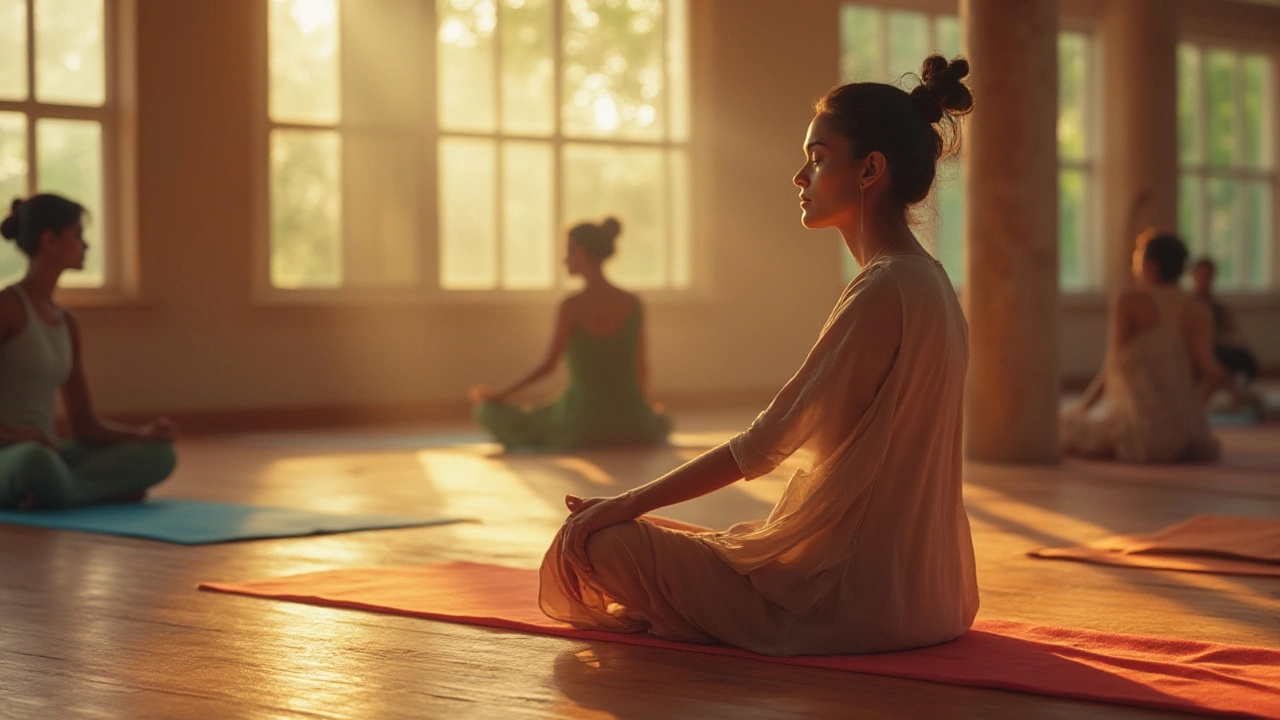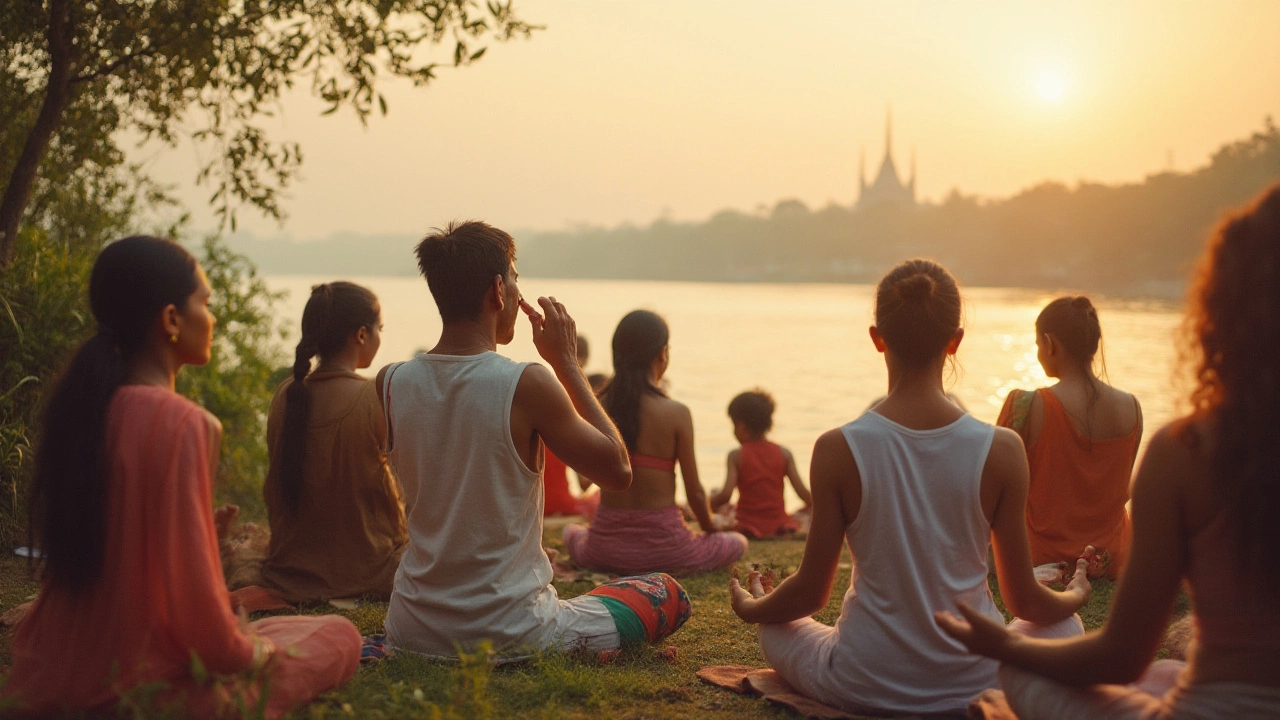Is Crying After Yoga Normal? Understanding Emotional Release During Yoga Sessions
 Jul, 31 2025
Jul, 31 2025
“Why do I always choke up after yoga?” If this sounds familiar, you’re in crowded company. No one warns you that yoga can gently twist more than your spine—it can unearth the tears you didn’t know were hiding. Maybe you’ve eyeballed your mat, blinking away a sudden sting of tears during Savasana, wondering if you’re having a meltdown, or just deeply weird. Truth is, crying after yoga isn’t rare or strange—it’s a real, physical response. It’s actually more common than messy hair after downward dog. Yoga asks your body to open, and sometimes, that “openness” means the floodgates have to do their thing.
Yoga and Emotions: Why the Floodgates Open
You might think yoga is all about stretching and holding weird balances, but there’s plenty happening under the surface—emotionally and physiologically. Here’s the piece lots of folks miss: our bodies are like vaults for emotional experiences, both the joyful and not-so-joyful ones. Baby Sadie cries when she’s tired, angry, or relieved. As adults, we like to pretend tough stuff stays quietly packed away, but it doesn’t—those feelings lodge themselves inside us, often in our muscles, fascia, or breath. Yogi and somatic therapist research has shown that hips, especially, are notorious for storing stress and trauma.
So, when you sink into pigeon pose and feel that uncomfortable stretch, it might stir up emotions tucked far beneath daily distractions. Add in slow breathing and that mind-body awareness, and suddenly, years of bottled-up feelings get free. Have you ever let out a big sigh during a pose? That’s not just air—it’s a vent for pent-up stuff. A 2018 study from Harvard found students in restorative yoga often reported emotional surges, sometimes leading to tears. Not sad tears, not happy ones either—just release. Yoga gives your mind permission to stop running circles, which sometimes unlocks the kind of feelings we keep too busy to notice.
There’s also the nervous system factor. Yoga activates your parasympathetic nervous system—the “rest and digest” mode—which acts like a calm-down button. Suddenly, you’re not on high-alert anymore. When that armor drops? So can the tears. Think of it as your body saying “finally, I get to let this out.”
Is Crying After Yoga Normal? Science and Stories
If you ever sniffled on your mat and glanced around guiltily, here’s some comfort: at least 36% of yoga practitioners surveyed in 2022 said they’d cried during or after a session. That’s not just anecdotal—real data backs this up. University of Wisconsin’s Center for Healthy Minds studied emotional responses after yoga and found regular practitioners reported “unexpected tears” and “rushes of emotion” more often than control groups who only did stretching without mindfulness.
Some yoga teachers even plan for it. In my favorite Saturday morning class, my instructor keeps tissues next to the blocks. She’ll say, “Don’t panic if you find yourself tearing up—it’s just your body doing spring cleaning.” The yoga community sees this as a badge of honor. When I whispered to a friend about my red blotchy face after a killer hip-openers session, she laughed and said, “That’s when you know yoga is working.” Turns out, emotional release is built into the process—the ancient yogis wrote about balancing the mind and purifying the heart alongside the physical postures.
Let’s get nerdy for a minute. Yoga engages the vagus nerve—the biggest nerve in your body for calming and restoring functions. Activating it through breath and movement can stir up dormant feelings. If you’ve ever read about Peter Levine’s work with somatic healing, you’ll see parallels—he found that when people finally feel safe and relaxed, suppressed emotions often bubble up. So what you experience is a perfect storm: physical stretches, mindful breathing, and nervous system downshifting. Even people who “never cry” suddenly melt during yoga.
| Yoga Style | Reported Emotional Release (%) | Common Emotional Responses |
|---|---|---|
| Yin Yoga | 41 | Tears, nostalgia, relief |
| Vinyasa Flow | 18 | Nervous giggles, overwhelm |
| Restorative | 44 | Quiet weeping, sudden calm |
| Hot Yoga | 13 | Irritability, release of frustration |

Dealing with Tears on the Mat: Practical Ways to Navigate Emotions
The first thing I want to say is, if you end up sobbing into your mat, it doesn’t mean you’re weak, off-balance, or broken. It means your body finally trusts you enough to let go. Still, knuckling tears away can leave you feeling awkward—especially if you’re in a busy class. Here’s what has helped me (and maybe helps you next time a wave hits you mid-pigeon):
- Give yourself permission. Yoga is literally about acceptance, not performance. If tears well up, try not to judge. The moment you accept it, the process becomes easier.
- Use your breath. If you sense an emotional tidal wave building, deepen your breathing. Slow inhales and longer exhales signal safety to your brain. This can help regulate runaway feelings without shutting them down.
- Mini-breaks are okay. No yoga teacher is offended if you curl up in child’s pose or step outside for a breather. Sometimes, pausing the flow is how you process emotions before returning.
- Don’t bottle it afterward. If you leave class feeling raw, take a gentle walk, journal, or talk to someone you trust. Ignoring your feelings can make them punchier next time. Recognizing and naming what you felt (“I’m not sad, just unburdened”) has real power.
- Remember what’s normal. Tears come up more in slower, deeper practices like yin or restorative yoga—but they can pop up any time. Some say certain poses like pigeon, camel, or heart openers “crack them open.” If you find yourself bracing for tears in particular poses, that’s not random. Your body may sense where old emotions are stashed.
What I teach my daughter Sadie—“feeling things is a superpower”—works just as well for grown-ups. If you sense embarrassment, remind yourself: the bravest thing you did today is let yourself feel.
Tips for Honoring What You Feel (Without Letting It Overwhelm)
Tears can be cathartic, but sometimes the overwhelm is real. You want to let emotions move through, but not hijack your day. Here’s a couple more practical tricks to keep your emotional health buoyant after a yoga session:
- Hydrate. Sounds simple, but water helps your nervous system reset after heavy emotions. Often, dehydration after crying can make your mood plummet.
- Ground yourself quickly. Firmly plant your feet on the floor and notice the ground beneath them. This “anchors” runaway emotions without needing fancy techniques.
- Phone a friend. Reach out to someone in your support circle—even if it’s just a quick text: “Yoga hit me right in the feels today.” That tiny bit of connection can help regulate emotional intensity, according to a massive UCLA mental health study.
- Try gentle movement. If you’re not ready to sit still, light stretching or even walking helps integrate big feelings so they don’t pool in your body.
- Practice non-judgment. This comes up a lot in yoga, but it’s not a cliche for nothing. Not every tear has a dramatic backstory. Sometimes it’s just built-up life steam. Let yourself off the hook for trying to “figure it out.”
- If the tears bring up deep or painful stuff from your past and you feel overwhelmed, talking with a mental health pro who understands somatic practices can be game-changing. Yoga can stir up buried emotions out of nowhere—that’s powerful, but sometimes needs extra support.
Remember, crying is a reset button, not a sign that something’s broken. Most people—even those sturdy types who claim they “never cry”—eventually realize yoga has a way of getting under the armor. And that’s its biggest gift: It clears out space for new strength, inside out.
